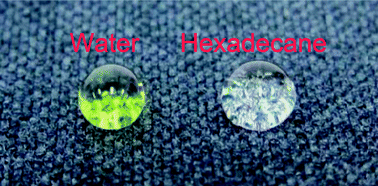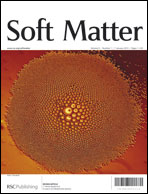A robust, electrically conductive, superamphiphobic fabric was prepared by vapour-phase polymerisation of 3,4-ethylenedioxythiophene (EDOT) on fabric in the presence of fluorinated decyl polyhedral oligomeric silsesquioxane (FD-POSS) and a fluorinated alkyl silane (FAS). The coated fabric had contact angles of 169° and 156° respectively to water and hexadecane, and a surface resistance in the range of 0.8–1.2 kΩ □−1. The incorporation of FD-POSS and FAS into the PEDOT layer showed a very small influence on the conductivity but improved the washing and abrasion stability considerably. The coated fabric can withstand at least 500 cycles of standard laundry and 10 000 cycles of abrasion without apparently changing the superamphiphobicity, while the conductivity only had a small reduction after the washing and abrasion. More interestingly, the coating had a self-healing ability to auto-repair from chemical damages to restore the liquid repellency.
You have access to this article
 Please wait while we load your content...
Something went wrong. Try again?
Please wait while we load your content...
Something went wrong. Try again?


 Please wait while we load your content...
Please wait while we load your content...